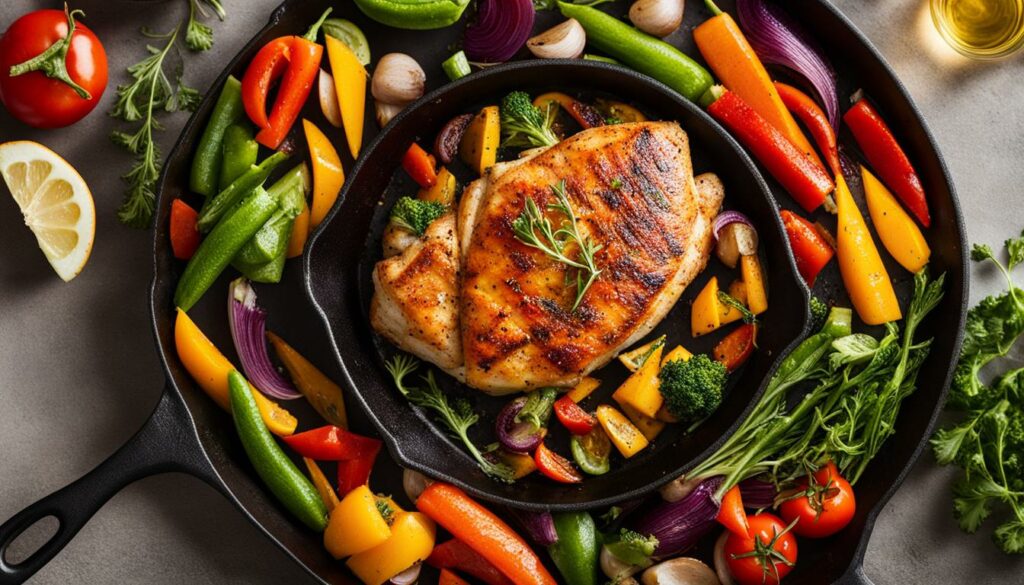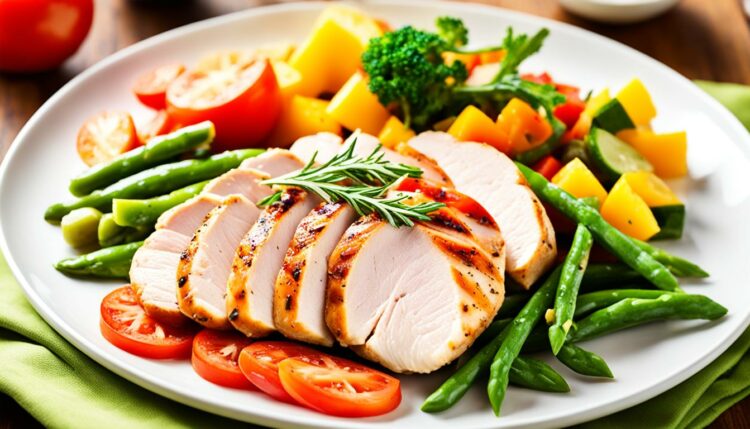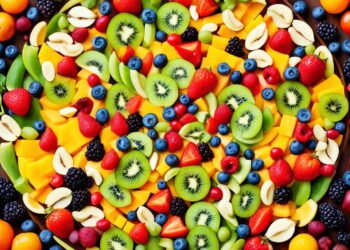Chicken breast is not only a popular choice among fitness enthusiasts and health-conscious individuals, but it also packs a punch when it comes to nutritional value.
Whether you’re looking to shed a few pounds, build muscle, or improve your overall well-being, incorporating chicken breast into your diet can provide you with the necessary fuel to achieve your goals.
Not convinced yet? Consider this: chicken breast is a lean protein source that offers a range of health benefits, from weight management to promoting heart health.
It is low in fat and calories, making it an ideal choice for those watching their weight and looking to maintain a healthy body composition. Additionally, chicken breast contains essential amino acids that contribute to stronger bones and muscles, supporting overall physical strength and vitality.
But that’s not all. The versatility of chicken breast makes it a go-to ingredient in countless recipes and cuisines, ensuring that you never get bored with your meals. From salads and stir-fries to sandwiches and wraps, the possibilities are endless when it comes to incorporating chicken breast into your culinary repertoire.
Key Takeaways:
- Chicken breast is a lean protein source that offers numerous health benefits.
- It is packed with essential amino acids that contribute to stronger bones and muscles.
- Incorporating chicken breast into your diet can aid in weight management and promote heart health.
- Chicken breast is a versatile cooking ingredient, allowing for endless culinary possibilities.
- By including chicken breast in your meals, you can enjoy a nutritious and delicious protein option.
Stronger Bones and Muscles
The lean protein in chicken breast provides essential amino acids that our bodies need to build muscle tissue. These amino acids play a crucial role in muscle health and the development of stronger bones.
As we age, it becomes even more important to maintain muscle mass and bone mineral density to prevent conditions like osteoporosis.
By incorporating chicken breast into your diet, you can support muscle growth and enhance bone health. The amino acids found in chicken breast help in building and repairing muscle tissue, making it a valuable protein source for individuals looking to build muscle or recover from physical activity.
How Amino Acids Improve Muscle Health
Amino acids are the building blocks of protein, and they are essential for the repair, growth, and maintenance of muscle tissue. Chicken breast contains a complete set of essential amino acids that our bodies cannot produce on their own, making it an excellent protein source for meeting our daily requirements.
One of the essential amino acids found in chicken breast is leucine. Leucine plays a vital role in stimulating muscle protein synthesis, which is the process by which our bodies build new muscle tissue.
Consuming adequate amounts of leucine-rich proteins, such as chicken breast, can enhance our body’s ability to build and maintain muscle mass.
In addition to leucine, chicken breast also provides other essential amino acids, including valine, isoleucine, and lysine, which contribute to muscle health and overall performance.
Promoting Bone Strength
Strong bones are essential for overall health and mobility. As we age, our bones gradually lose density, increasing the risk of fractures and osteoporosis. Protein intake, particularly from sources like chicken breast, can help maintain bone mineral density and reduce the risk of bone-related injuries.
The amino acids found in chicken breast play a vital role in maintaining bone health. Studies have shown that higher protein intake is associated with improved bone mineral density and reduced risk of fractures in older adults.
Furthermore, chicken breast is a natural source of phosphorus, a mineral that’s essential for bone formation and strength. Consuming phosphorus-rich foods like chicken breast can contribute to the maintenance of strong and healthy bones.
“The protein found in chicken breast provides the necessary amino acids for building muscle tissue and maintaining bone strength. By including chicken breast in your diet, you can support muscle health, promote bone mineral density, and reduce the risk of conditions like osteoporosis.”
| Amino Acids in Chicken Breast | Amount per 100g |
|---|---|
| Leucine | 2.33g |
| Valine | 1.32g |
| Isoleucine | 1.29g |
| Lysine | 2.38g |
These essential amino acids found in chicken breast support muscle tissue growth and maintenance, improving muscle health and promoting bone strength.
Weight Management and Heart Health
When it comes to weight management and heart health, incorporating chicken breast into your diet can be a smart choice. Research suggests that protein-rich meals, like chicken breast, can promote feelings of satiety, helping to reduce overall calorie intake and support weight management goals.
Chicken breast is a low-fat protein source that can help you feel fuller for longer periods, potentially curbing cravings and preventing overeating. By prioritizing protein intake, you can maintain a balanced diet and support your weight management efforts.
In addition to its weight management benefits, chicken breast is also a heart-healthy protein option. It contains low levels of saturated fat, which can contribute to the development of heart disease.
By replacing higher fat protein sources with lean chicken breast, you can reduce the risk of heart disease and its associated risk factors.
A study published in the Journal of the American College of Nutrition found that consuming poultry, such as chicken breast, can lead to improvements in heart health markers, including reduced levels of triglycerides and blood pressure.
These improvements are essential in managing heart disease risk factors and maintaining overall cardiovascular wellness.
| Benefits of incorporating chicken breast into your diet: | Heart Health | Weight Management |
|---|---|---|
| Promotes satiety and reduces overall calorie intake | Reduces the risk of heart disease | Supports weight loss efforts |
| Low in saturated fat | Improves heart health markers | Helps maintain a healthy weight |
| Provides essential nutrients and amino acids | Supports overall cardiovascular wellness | Helps build lean muscle mass |
By incorporating chicken breast into your meals, you can enjoy its weight management benefits while also contributing to a healthier heart.
However, it’s important to note that the cooking and preparation methods of chicken breast can impact its overall nutritional profile. Ensure that you choose healthy cooking methods, such as baking or grilling, and limit the use of added fats or oils.
Remember, maintaining a balanced diet and incorporating a variety of nutrient-rich foods is crucial to overall health and well-being. Chicken breast can be a valuable addition to your diet, supporting weight management and heart health goals.

Better Mood
Chicken breast contains the amino acid tryptophan, which is linked to higher levels of serotonin, a neurotransmitter associated with mood regulation.
While the tryptophan levels in chicken breast may not cause instant mood elevation, studies suggest that it can contribute to boosting serotonin levels when combined with other factors.
Researchers have found that serotonin plays a crucial role in mood regulation and is often referred to as the “happy hormone” due to its impact on feelings of well-being and happiness.
It helps to stabilize mood, improve cognitive function, and regulate sleep patterns. Low serotonin levels are associated with conditions such as depression and anxiety.
By including chicken breast in your diet, you can provide your body with the necessary tryptophan to support optimal serotonin production.
While some sources suggest that tryptophan may have a mild antidepressant effect, it’s important to note that it is not a cure for mood disorders or a substitute for professional medical treatment.
“Serotonin is an important neurotransmitter involved in the regulation of mood, sleep, appetite, and cognitive function. By consuming foods rich in tryptophan, such as chicken breast, you can support serotonin production and potentially improve mood regulation.”
Combining Tryptophan-Rich Foods
To enhance the mood-boosting effects of tryptophan, it is recommended to combine tryptophan-rich foods with sources of carbohydrates, such as whole grains.
This combination stimulates the release of insulin, which helps to clear other amino acids from the bloodstream, allowing more tryptophan to enter the brain and potentially increase serotonin levels.
Including foods like brown rice, quinoa, sweet potatoes, or whole wheat bread with your chicken breast can optimize tryptophan absorption and potentially contribute to mood regulation.
Overall, while chicken breast can provide tryptophan to support serotonin production, it is important to remember that mood regulation is influenced by various factors, including lifestyle, genetics, and mental health.
If you are experiencing persistent mood disturbances, it is essential to consult with a healthcare professional for a comprehensive evaluation and appropriate treatment.
Nutritional Value of Chicken Breast
Chicken breast is a nutritious choice that provides high-quality proteins and essential nutrients. It is a rich source of vitamins and minerals, including selenium, phosphorus, vitamin B6, and niacin. These nutrients play vital roles in supporting overall health and well-being.
Proteins are the building blocks of our body, essential for repairing tissues, building muscles, and maintaining a healthy immune system. Chicken breast provides a substantial amount of lean protein, making it an excellent option for those looking to meet their protein requirements.
In addition to proteins, chicken breast contains important vitamins and minerals that contribute to the proper functioning of the body. Here is a breakdown of some key vitamins and minerals found in chicken breast:
| Vitamins | Minerals |
|---|---|
| Vitamin B6 | Selenium |
| Niacin | Phosphorus |
These vitamins and minerals play crucial roles in supporting energy metabolism, brain function, and promoting healthy bones and teeth.
While chicken breast is a nutritious choice, it is important to consume it in moderation due to its cholesterol content. The American Heart Association recommends limiting cholesterol intake to maintain heart health. Additionally, portion sizes also need to be considered for overall balanced nutrition.
Ensuring food safety is essential when preparing chicken breast. Proper handling, cooking, and storage can help prevent foodborne illnesses. It is important to follow safe food practices, such as washing hands thoroughly, cooking chicken to the recommended internal temperature, and avoiding cross-contamination with other foods.
Overall, chicken breast offers a nutritious combination of proteins, vitamins, and minerals. Incorporating it into a balanced diet can contribute to overall well-being and support a healthy lifestyle.
Cooking and Preparation Tips
When it comes to cooking chicken breast, following proper techniques is essential to ensure food safety and maximize flavor. Here are some important tips to keep in mind:
Cooking Temperature:
It is crucial to cook chicken breast to the correct internal temperature to eliminate any harmful bacteria. The recommended cooking temperature for chicken breast is 165 degrees F (74 degrees C). This ensures that the chicken is fully cooked and safe to consume.
Thawing Methods:
If you’re using frozen chicken breast, thaw it thoroughly before cooking. The safest way to thaw chicken is by refrigerating it overnight.
However, if you’re short on time, you can use the defrost function on your microwave or place the chicken in a sealed plastic bag and submerge it in cold water. Avoid thawing chicken at room temperature, as it can promote bacterial growth.
Cooking Time:
The cooking time for chicken breast can vary depending on the thickness and cooking method. Here are some general guidelines:
- Grilling: Approximately 8-12 minutes per side for boneless, skinless chicken breast.
- Baking: Bake boneless, skinless chicken breast at 400 degrees F (204 degrees C) for 20-25 minutes.
- Sautéing: Cook boneless, skinless chicken breast in a skillet over medium heat for 6-8 minutes per side.
Always use a meat thermometer to ensure the chicken breast reaches the recommended internal temperature of 165 degrees F (74 degrees C) before removing it from the heat source.
Food Safety:
Food safety is paramount when handling chicken breast. Here are some important food safety practices:
- Prevent cross-contamination by keeping raw chicken separate from other foods. Use separate cutting boards, utensils, and plates for raw chicken.
- Wash your hands thoroughly after handling raw chicken and before touching other ingredients or surfaces.
- Properly clean and sanitize all surfaces and utensils that come into contact with raw chicken.
- Store leftover cooked chicken breast in a sealed container in the refrigerator for up to 3-4 days.
Recommended Cooking and Storage Guidelines:
Follow these recommended guidelines to ensure safe and flavorful chicken breast:
“Proper cooking temperature, thawing methods, and food safety practices are crucial for delicious and safe chicken breast dishes. By following these tips, you can confidently prepare mouthwatering meals while ensuring the highest standards of food safety.”
| Cooking Method | Recommended Internal Temperature | Cooking Time |
|---|---|---|
| Grilling | 165°F (74°C) | 8-12 minutes per side |
| Baking | 165°F (74°C) | 20-25 minutes at 400°F (204°C) |
| Sautéing | 165°F (74°C) | 6-8 minutes per side |
Remember, proper cooking techniques, temperature control, and attention to food safety guidelines are key to enjoying delicious and safe chicken breast dishes.
Versatility of Chicken Breast
When it comes to cooking ideas and recipes, chicken breast offers endless possibilities. This versatile ingredient can be transformed into a variety of mouth-watering dishes that will satisfy all taste buds. Whether you prefer a light and refreshing salad or a hearty grilled meal, chicken breast has got you covered.
Sliced for Sandwiches
One classic way to enjoy chicken breast is by slicing it for sandwiches. Layer it with your favorite veggies and condiments between two slices of bread. The result? A delicious and satisfying meal that can be enjoyed on the go or at home. It’s a versatile option for a quick lunch or dinner.
Grilled with Rice or Vegetables
Grilled chicken breast paired with rice or vegetables is a nutritious and flavorful option. The smoky charred flavor of the grilled chicken combined with the wholesome goodness of rice or seasonal vegetables creates a well-balanced and satisfying meal.
It’s perfect for those looking to add more protein to their diet while incorporating healthy grains and greens.
Shredded in Salads or Wraps
For lighter options, chicken breast can be shredded and added to salads or wraps. The tender and juicy chicken provides a protein-packed boost to your greens, creating a filling and nutritious meal. Add your favorite dressing or sauce for an extra burst of flavor.
Substitute for Beef in Burgers
If you’re looking for a healthier alternative to beef burgers, chicken breast is the way to go. Ground chicken breast can be seasoned and formed into patties, offering a leaner option for burger lovers.
Top it with your favorite toppings and enjoy guilt-free indulgence. It’s a fantastic choice for those watching their calorie intake without compromising on taste.
Tossed with Pasta
Chicken breast can also be diced and tossed with pasta for a hearty and satisfying meal. Whether you prefer a tomato-based sauce or a creamy Alfredo, the chicken breast adds a protein element to your pasta dish, making it more filling and nutritious. Sprinkle some Parmesan cheese on top for an extra touch of flavor.
“With its versatility, chicken breast can easily take on different flavors and cuisines. From Asian-inspired stir-fries to Mediterranean-style dishes, the options are truly endless.”
With its ability to adapt to various flavors and cuisines, chicken breast is a staple in many kitchens. It’s a versatile ingredient that can transform any meal. Get creative and experiment with different seasonings, marinades, and cooking techniques to discover new and exciting chicken breast dishes that will impress your family and friends.
| Cooking Ideas | Recipe Suggestion |
|---|---|
| Chicken Caesar Salad | Classic salad with grilled chicken breast, fresh romaine lettuce, homemade croutons, and tangy Caesar dressing. |
| Teriyaki Chicken Stir-Fry | A flavorful stir-fry with tender chicken breast, colorful vegetables, and a tangy teriyaki sauce served over rice or noodles. |
| Caprese Chicken Sandwich | A delicious sandwich with grilled chicken breast, mozzarella cheese, fresh tomatoes, basil leaves, and a drizzle of balsamic glaze. |
| Chicken Alfredo | A creamy pasta dish with grilled chicken breast, fettuccine pasta, and a rich Alfredo sauce. |
| Buffalo Chicken Wrap | A spicy wrap with shredded buffalo chicken breast, crisp lettuce, diced tomatoes, and a creamy ranch dressing. |

As you can see, the versatility of chicken breast allows for a wide range of delicious and healthy recipes. Whether you’re planning a quick weeknight dinner or a special weekend meal, chicken breast is sure to impress with its endless possibilities.
Conclusion
Chicken breast is a powerhouse of nutrition, offering a multitude of health benefits. As a lean protein source, it provides the essential amino acids necessary for muscle building and repair.
Incorporating chicken breast into your diet can result in stronger bones and muscles, reducing the risk of injuries and conditions like osteoporosis. Not only does it support weight loss by promoting satiety, but it is also heart-healthy due to its low saturated fat content.
With its high nutritional value, chicken breast is an excellent choice for those looking to improve their overall health and well-being. Packed with vitamins, minerals, and low in cholesterol, it offers a balanced blend of nutrients.
Whether you prefer grilling, roasting, or using it as a key ingredient in various dishes, the versatility of chicken breast allows for endless culinary possibilities.
For individuals aiming to shed pounds or build muscle, chicken breast is a fantastic addition to your diet. Its high protein content aids in weight management while providing the necessary fuel for muscle growth.
By embracing chicken breast as part of a balanced eating plan, you can enjoy the benefits of this lean, heart-healthy protein source and relish in its delicious flavors.
FAQ
What are the health benefits of chicken breast?
Chicken breast is a lean protein source that offers numerous health benefits. It is low in fat and calories, making it an ideal choice for weight loss and muscle building.
It also contains essential amino acids that contribute to stronger bones and muscles. Chicken breast is a versatile cooking ingredient and a heart-healthy protein option.
How does chicken breast contribute to stronger bones and muscles?
The lean protein in chicken breast provides essential amino acids that our bodies need to build muscle tissue. This is especially important as we age, as higher protein intake helps maintain bone mineral density.
By incorporating chicken breast into your diet, you can promote healthier bones, reduce the risk of injuries, and prevent conditions like osteoporosis.
Can chicken breast help with weight management and heart health?
Research suggests that protein-rich meals, such as chicken breast, can help in weight management by promoting feelings of fullness and reducing overall calorie intake. Additionally, chicken breast is low in saturated fat, making it a heart-healthy protein option that can help in reducing the risk of heart disease.
It can lead to improvements in risk factors such as high triglyceride levels and high blood pressure.
Does chicken breast have an impact on mood?
Chicken breast contains the amino acid tryptophan, which is linked to higher levels of serotonin, a neurotransmitter associated with mood regulation.
While the tryptophan levels in chicken breast may not cause instant mood elevation, studies suggest that it can contribute to boosting serotonin levels when combined with other factors.
What is the nutritional value of chicken breast?
Chicken breast is packed with high-quality proteins and essential nutrients. It contains vitamins and minerals such as selenium, phosphorus, vitamin B6, and niacin. However, it is important to consume chicken breast in moderation as it does contain cholesterol.
The USDA recommends limiting portion sizes of protein, including chicken breast, and practicing proper food safety measures to prevent the risk of foodborne illnesses.
What are some cooking and preparation tips for chicken breast?
When cooking chicken breast, it is crucial to ensure that it reaches a safe internal temperature of 165 degrees F to prevent bacterial growth. Different cooking methods and cuts of chicken breast will require varying cooking times.
It is important to thaw frozen chicken properly and practice proper food handling techniques to prevent cross-contamination. Follow recommended cooking and storage guidelines to ensure food safety.
How can chicken breast be used in cooking?
Chicken breast is a versatile ingredient that can be used in various dishes. It can be shredded in salads, grilled with rice or vegetables, sliced for sandwiches, used as a substitute for beef in burgers, tossed with pasta, or wrapped in a wrap. The possibilities are endless, making chicken breast a staple in many recipes and cuisines.
What are the key takeaways regarding the benefits of chicken breast?
Chicken breast is a nutritious and versatile protein source with numerous health benefits. It provides essential amino acids for building muscles, promotes stronger bones, aids in weight management, and supports heart health.
Incorporating chicken breast into a balanced diet can provide a range of nutrients while offering a lean and delicious option for various recipes.




